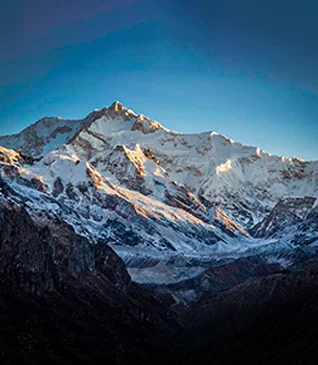Winter treks are full of thrill and adventure and at the same time, they also pose challenges like battling cold weather and sometimes extremely so. While you will always feel a degree of cold in the snowy treks, that doesn’t mean you can’t try to keep yourself as warm as possible. Since winter is here and you are all ready for your winter adventures, we thought of sharing some useful hacks to tackle the freezing temperatures. Here are some excellent tips to keep you warm in the coldest of treks.
Layer Up From Head To Toe

You keep hearing about wearing layers all the time but this is one of the primary remedies to stay warm with the least effort. While we stress on wearing multiple layers to keep you warm, you also need to wear the right layers on both the upper and lower parts of your body to keep your body temperature regulated. Oftentimes, we see trekkers wearing five layers of clothing on their upper body and only a single layer on the lower body. This is not the appropriate way of clothing. You have to layer your lower body as well as your upper body appropriately. Here’s what we suggest:
For upper body
– Thermal layer
– T-shirt (full-sleeves preferred)
– Another layer of T-shirt/Shirt (for extreme colds)
– Fleece layer
– Thick Jacket
– Waterproof or Windproof jacket (outermost layer when it is snowing or raining)
For Lower Body
– Thermal layer
– Hiking pants (normal) or only one Winter hiking pants can work
Based on how warm you feel you can skip any of the above layers. But the idea is instead of
The idea behind layering is that the more insulation you have the less cold you feel, and instead of wearing a very thick jacket if you wear multiple layers, your body will be better insulated against the cold.
Avoid Wearing Padded Jackets Inside Sleeping Bags

Padded jackets are great for insulation but you should not wear them inside while sleeping. It is recommended to wear thermals, T-shirts, fleece jackets, and woolen socks and caps inside the sleeping bag. A padded jacket makes the purpose of using a sleeping bag ineffective.
The way a sleeping bag works is by circulating your body heat inside the bag to keep you warm and to protect you against the outside cold. A sleeping bag thus becomes the barrier between the outside cold and your body. When you wear a padded jacket inside the bag, it prevents the bag from regulating your body heat. When it comes to sleeping in sleeping bags, always prefer softer materials like wool, fleece, etc, and not rigid materials like padded jackets, down jackets, windcheaters, etc. Additionally, you can also keep a bottle of warm water in your sleeping bag to keep you warmer.
Eat Full Meals

While during the winters, you may not feel like eating much it is recommended not to forgo any meals, especially your dinner. This is because a full meal keeps your digestive system working, generating more body heat. The less you eat on your trek, the more you will struggle with the cold. You will find it surprising how such a small action can play a big role in keeping your body warm.
Ditch Drinking Cold Water

In winter treks it is best to avoid drinking cold water and stick to warm drinks. Gulping down cold water will immediately undo all the efforts that you took in keeping your body warm, instead stick to warm water. Staying warm by drinking warm liquids is a great trick to keep your body warm. Carry an insulated flask with you to store hot water and you can sip on your flask to stay warm and cozy whenever you feel like you are getting a little too cold. Another added benefit of drinking warm water is that it prevents sore throats, cough, and cold due to the cold weather. Apart from water, you can occasionally sip some warm tea as well. Keeping tea bags with you is quite handy. However, we do not recommend drinking coffee as it dehydrates you and does nothing to keep you warm.
Avoid Sweating
While it is a little hard to prevent sweating altogether on the trek make sure that you are not sweating excessively. Too much sweat can make you feel really cold, real fast and you do not want that. When your body’s perspiration meets the windchill, it will make you feel extra cold. To prevent this from happening, keep removing and adding layers when you are moving and when you are resting to avoid too much sweating. While trekking during the daytime, your body will generate enough heat to keep itself warm so you will not need as many layers as you will need at night. However, layer yourself up as soon as you reach the campsite before your body cools down, to keep it at a regulated temperature.
Use The Right Shoes

In the snowy treks, it is essential to keep your feet dry and a good pair of hiking shoes can also act as a great layer of insulation. When you choose your snow-hiking shoes, choose them wisely and make sure they have a durable and waterproof membrane that prevents moisture from getting inside your feet. A good pair of hiking shoes can make a world of difference in sub-zero conditions. Also, make sure that the shoe is not very heavy but snug, solid and at the same time lightweight.
Keep Your Thoughts Positive
However, it may happen that despite all the efforts of keeping warm, you may still feel cold. At last, your mind is the savior. Don’t let worries about the cold keep you trapped in your mind, remember to have fun and distract yourself from any negative thoughts. A strong mind can fight anything. The more you keep thinking about the cold the more you will feel it. Keep your spirits high and enjoy the experience.
Trekking in The Himalayas during the winter is an adventure-filled journey but at the same time, you should take the right measures to regulate your body temperature. Follow the above-mentioned tips to keep yourself warm while trekking through sub-zero temperatures.





.webp)










.webp)


